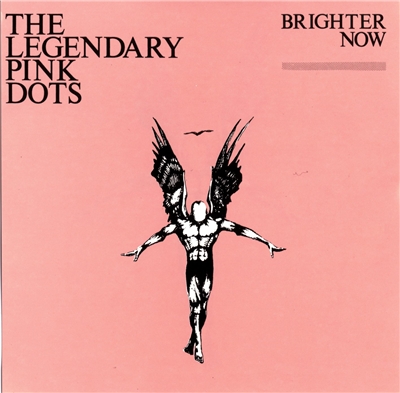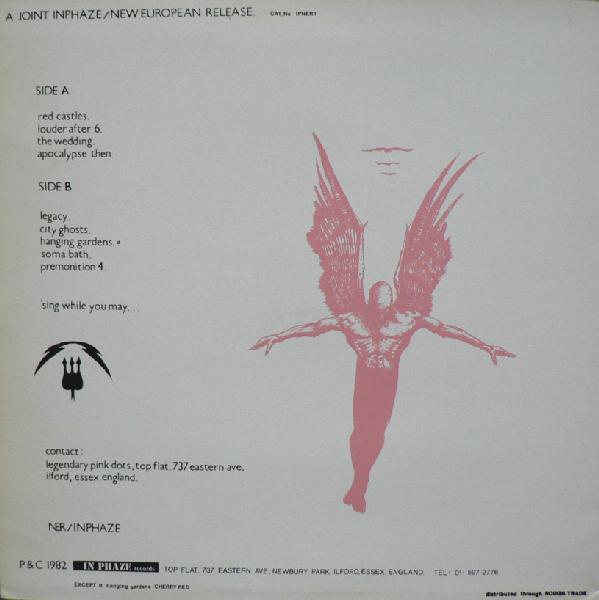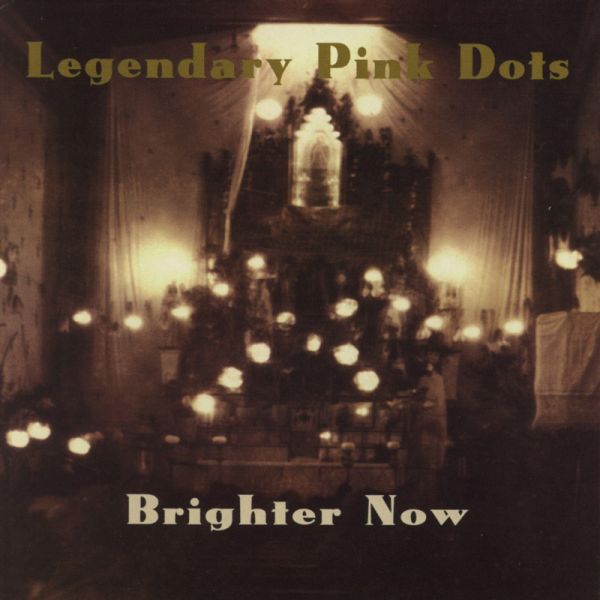
Edward Ka-Spel‘s brilliance with The Legendary Pink Dots is to introduce us to isolated characters and then immerse us in their world-view through expansive and mysterious soundscapes. He begins with the most restricted, infinitesimal point of consciousness and then slowly expands it outward towards a state of ‘cosmic consciousness’ (to use the phrase of 1960s psychonauts). Musically, he often follows this template of expansion, with simple melody lines repeating and layering in increased complexity of texture. Much of the LPD’s music is an undertaking to help the listener (and perhaps composer) escape his/her own head. Lyrical phrases, musical motifs, album titles and themes recur across decades, but tonal shifts between albums are slow and subtle. Hopefully, The Legendary Dots Project, like the Residents and Sparks projects before, will provide the keen reader and listener with a giddy entry-point into the Legendary Pink Dots’ musical world. Fulfil the prophecy!
Adam: The official L.P.D. debut on vinyl is a glossier and more pop-friendly affair than previous cassette-only releases. The material is pared down, with a greater consistency of tone and focus across the tracks, however this also means there is less going on than in colossal shambling behemoths like Chemical Playschool 1 & 2. The increased clarity and accessibility is also mirrored in Ka-Spel’s lyrics, in which a new-found directness replaces the esoterica of before… a directness that would cross over into universalising allegory with The Tower by 1984. In more recent albums still, such as personal favourite Your Children Placate You From Premature Graves, Ka-Spel achieves a synthesis of the esoteric, the direct and the allegorical in his lyrics. Personally, I prefer my Dots a notch more sinister and malevolent than on Brighter Now (even the title implies a comparative turn away from darkness) and I truly admire the fact that the band didn’t merely become progressively more and more radio friendly with each release and that far weirder albums like The Maria Dimension were yet to come.
The album begins with “Red Castles”, surely out of the new tracks, the one that would fit most appropriately on the cassette-only releases, with its flattened, low-key sound and lyrics that place grubby pubs alongside Arthurian imagery, with a pleasing piece of wordplay in “a tramp chews a dog ends, a dog chews a tramp”. I find it all somewhat structureless, however. “Louder After 6” is more intriguing – an ironically jaunty ditty about surveillance, the Kremlin and phone-tapping. This is warped 1980s elevator music, with wry humour replacing dour prophecy. It even contains a jabbering medley of sped-up chipmunk voices a la Joe Meek.
Things become more subdued for “The Wedding”, a sombre piece of chamber pop in which Ka-Spel sounds for the first time like a young man, fearing romantic commitment if it means committing himself to Christian dogma. It is an anxious, disarmingly earnest song, underpinned by a lovely, plaintive repeated piano melody. “Why do we have to be so humble… mumble words we never mean?” asks Ka-Spel. With the production of the album cleaner and sparser than has come before, the simplicity of the music is very effective and this might be one of the most directly moving songs in the Dots’ early catalogue.

“Apocalypse Then” gave me a daft, silly grin the first time I heard it. It is deceptively atmospheric, but reveals downright daft lyricism with attentive listening. I’m certain Ka-Spel coins the phrase “hot like custard” and even allows himself the diabolically rubbish pun “demo-crazy”. As with the Dots generally though, humour and horror are kept in stark juxtaposition. A line about “helter-skelter in the lift shaft” had me wondering whether a deliberate reference to the Manson Family murders was being made. However, any darkness or commentary in the song seems a bit too on-the-nose to be taken entirely seriously. It all ends in chanted sieg heils.
Yet, there’s more earnestness brought to the table with “Legacy”, which (a little uncharacteristically) contains the kind of confessional tragic-romantic songwriting perfected by The Cure on Disintegration in 1989. “Legacy” is followed by “City Ghosts”, which is one of those songs that just works. Ka-Spel is at his most melodic, even delicate and boyish, as he sings about taking magic mushrooms in a forest with a companion, friend or possible lover, with powder in his pocket that cries “Eat me!” like a pastry out of Alice. Brilliantly, the music cuts out for the line, “Face facts. Face the real world” – the eternal sentiment chanted by serious-minded adults that turns teenagers to stone. The song, which begins so innocent and free, ends in the paranoia of experience, with the fear of being locked up and institutionalised for childish transgressions. It is a beautiful elegy for the end of youth and my personal favourite on the album. Thematically, “City Ghosts” is grouped with “Hanging Gardens” (a song that coincidentally shares a name with a track off The Cure’s Pornography) which also makes authority sound like the absolute enemy of freedom and poetry and beauty. Behind the signature L.P.D. electronics, there is a refreshingly organic piece of acoustic finger-style guitar. Oddly, if one just looks at the lyrics, rather than listening to the song, “Hanging Gardens” reads like a particularly arty and abstract Irish murder ballad!
One of the issues with the sheer amount of releases that the Dots put out in this period (on a couple of different labels) is that a few songs crop up again and again. We here at Kittysneezes have heard “Soma Bath” rather a lot of times now. It is good, but there are only so many times one can hear about the fate of a junkie prophet.
It was perhaps inevitable that a Dots track would begin with a nursery rhyme refrain sooner rather than later. One sensed that Ka-Spel could only hold off for so long. “Premonition 4” starts off with ‘Ring-A-Ring-A-Roses’. It is a long, moody soundscape recalling Bauhaus or even Baader-Meinhoff. There are some pleasing noises that might involve a radiator being struck (hopefully the mysterious and portentous one from Henry’s room in David Lynch’s Eraserhead!) It is worthy, but dispensable and makes for a moderately underwhelming end to the album.
Then it’s all over and while there have been a handful of wonderful songs, the overall effect just about fails to be greater than the sum of its parts. Brighter Now is a little slight. It gratifies, but without the grandeur or intensity of which the Dots are capable. I would highly recommend its softer moments, with “City Ghosts” being a miniature masterpiece to my ears, but Brighter Now reminds you that the Dots had only just gotten started and were to scale far greater and more muscular and formidable heights by the end of the decade.

Matt: One of the first things that leaps out at me is how similar the organ on this version of “Louder After Six” sounds so much like the E-Z Listening Version of DEVO’s “Come Back Jonee”; I don’t know if it’s an intentional reference on DEVO’s part (while there were a few musical in-jokes and references on those tapes, I’m not sure if when they were recording if DEVO was aware of the Dots), but either way it’s pretty interesting. Who knows — maybe it’s a shared reference of something I’m just not aware of, or maybe… just maybe… it’s a complete coincidence.
I’m not sure what to make of Brighter Now being the first vinyl release from the Dots. Aside from being (much) shorter than the other stuff we’ve listened to for this project, it feels much like the other tapes. If you’re looking for a fancy studio recording or anything like that, something produced by George Martin and Alan Parsons at Abbey Road, you’re going to have to keep on looking. Admittedly, that’d be something I’d like to hear, though…..
But an album rises and falls on the quality of its songs, so let’s talk about those! I quite enjoyed “Red Castles” (and, as the token American in this project, I have to point out that “dog-end” is slang for a cigarette butt lest anyone think the dog is chewing on the tramp in retaliation), and though I’ve heard it and “Louder After Six” before, they’re both great songs to start an album with. I quite liked “The Wedding” too, which takes the trope of the “I don’t know why you chose me to fall in love with, I am so lucky and not worthy” song, and makes it sinister; one gets the implication that the narrator is indeed not worthy and is not perhaps the best person in the world. It kind of bookends with “Legacy”, at least in my mind, where after the diversion of “Apocalypse Then”, which lands between the two songs, the couple’s shared flat is empty, though it’s not the narrator who ran off as predicted in “The Wedding”, but the bride — and it’s revealed that while in “The Wedding” it’s not clear at all, the narrator did indeed care for the bride. (I don’t even know if these songs are supposed to be related or not, but that’s how they felt in my brain.)
Speaking of the meat of that song-sandwich, “Apocalypse Then” is catchy and I quite like the guitar riff– this version is remarkably unsubtle. The lyrics are a bit on-the-nose (I am amused that Adam and I chose the exact same phrase to describe this song), but the sample at the end of the crowd chanting “Sieg Heil” is really obvious and, well, cheap. (The version on Chemical Playschool 1 & 2 omits this, along with the first verse, to its benefit — it’s overall a much more effective version.) I do like the Thatcher sample in the song though — twisting her “crime is crime is crime” comment into an indictment of the Miltary-Industrial Complex and all. But while a lot of Ka-Spel’s best works are a bit crystalline, this “Apocalypse” just up and more-or-less says outright what it means, and I think it suffers for that. There’s not enough to chew on there.
Huh. Sandwiches and chewing. Maybe I’m hungry.
I could make some sort of lame segue between that and the “Eat me eat me eat me” line in “City Ghosts”, but that would be stupid. That song, however, is really good — atmospheric, and a description of a drug-induced hallucination complete with paranoia and horrifying visions and spiritual significance. The drum sounds they got on this track are interesting — I really like them; they’re perhaps not recorded exactly right, but the imperfections in technique end up making some really interesting sounds. The segue to “Hanging Gardens” is just about perfect too. And I love how that song folds back on itself. Back when I was doing the TODCRA stuff, I always tried to put a “Playing Card” song on each album — where it’d play out, then reverse at the end. I’ve always been kind of obsessed with that concept. (If I were better, I’d have done actually palindromic songs that sounded good… but then if I were better, I’d have actually done songs that sounded good.)
Anyway — Brighter Now, being more bite-sized, would probably be a pretty good introduction to the Dots — or at least this era of them. Lots of strong songs, and a little bit more accessible without casting off the weirdness that make them cool and interesting. Though I still do want to hear what they’d do with an all-star production crew and billions of dollars to record a record…. Kickstarter, anyone?
PS: …are… are we done with “Soma Bath”? It’s a good song, but there’s only so much one can say about it! I guess we could talk about whether or not the figure is Elvis, or just an Elvis-inspired figure. But I’m pretty sure it’s Elvis.

Tom: ‘Louder after 6’ is affable, with its loping rhythm and curious paranoid scenario. I liked the post-John Foxx, proto-’Ghostbusters’ synth flourishes around the two-minute mark. Like ‘Red Castles’, it is compressed and tidy compared to the version on CP1&2. However, this version is more distinctive than ‘RC’’s: the glugging crawl of ‘Louder after Six’ is replaced by a loosened up pop song of sorts. For me, an advance.
‘The Wedding’ also benefits from a more expansive production. Its central, cyclical piano motif sounds deeper, sharper and more achingly dismal than before. All is sepulchral – the chilly sentiments are brought into greater focus. Spare, bare, direct – Ka-Spel’s voice is now clearer and more insidious; his doubting, candid words hit hard. To complete one of the album’s two triumphs, a mock-congregational choir moans into view from 3:30: a drawn-out “Amen!” Then, after thirteen seconds or so: cut off, like a coffin lid shutting tersely.
‘Apocalypse Then’ starts with a faint British national anthem, then into a distinctly less psychedelic, submerged version of CP1&2’s ‘Apocalypse Now’. It is even mellifluous at times, with delay-soaked guitar lapping about. I do like this, with its surreal, garish lyrics – ‘A dog defaced a baby; gnawed a rattle, smashed a pram. He was yelping wildly in a vacuum. No-one really gave a damn’ – cloaked by an innocuous seeming musical backing.
After the earlier puns of ‘demo-crazy!’ and mention of ‘the last day’, a contemporary political edge emerges: the Thatcher sample from an earlier album is reused. “Crime is crime is crime”, on top of minor-key synth chords. This being 1982, Ka-Spel is surely responding to the baleful impact of Thatcher’s Falklands War-inspired ascendancy on British culture: ‘No-one really gave a damn. They were thinking only of themselves…’ The end section is a justly bitter tirade:
‘And the radio screams out, “We’re winning!” And about how the loss was minimal and how the gallant sacrifice will live on in memorials, and how we’ll respect again. We’re no playground anymore. You cannot keep this country down for long, because we win so many fucking… wars.’
Totalitarian crowd sounds are dispersed by an explosion and then we into a musique concrete melding of the chimes of Big Ben and a creaking musical box. It’s a pointed, vivid, seven-minute shriek. Seven minutes which evoke that Edvard Munch painting and Allen Ginsberg’s scathing poetic attack ‘America’.

Then, it all dissipates a tad. While ‘Legacy’ is increasingly lavish, but I am unsure whether I prefer this to its original airing on CP1&2. Brought up close, it seems a bit more mannered, less anguished. There’s more musicianship in the undoubtedly nifty guitar playing, but it just doesn’t feel as secluded and enclosed… Still, a cracking song and a version that is sufficiently distinct to be justified – the differences tend to be less minute than those between some tracks on earlier LPD releases. ‘City Ghosts’ lacks that gadding high-pitched synth lead part it had previously; though the often extraordinary lyrics stand out amid the crisper auditory field: ‘A shadow rests, suggests no entry. A tramp complains, collapses weeping gently. A figure smiles and shines a blade discretely. And the drains ad-libbed a soundtrack as he picked his victim out.’ This is an absurdist, melodious take on the urban film noir.
‘Hanging Gardens’ didn’t grab me especially in its previous form and doesn’t here when expanded to over nine minutes. ‘Soma Bath’ comes as a bracing relief after this, despite the fact that it is the third version we have encountered in the four releases covered thus far. ‘Witnesses were D.O.A. O.D’d, amoral, senses skewered.’ When I first heard this track, I thought I heard some curious discussion of a ‘D-Day moral’!
Characteristically, The Legendary Pink Dots provide ‘Premonition 4’ before 1, 2 and 3. A rendition of the perennial English nursery rhyme ‘Ring a Ring o’ Roses’ unfurls. This rhyme has – rightly or wrongly – been associated with the Great Plague of 1665 ever since the publication of Peter and Iona Opie’s Oxford Dictionary of Nursery Rhymes in 1951. The ‘fall’ in the rhyme may allude to children curtseying or dying. These cheerless prospects are then submerged in a dejected, disorientated miasma: indistinct voices burbling, cheeks cracking in slow motion. The presentiment ends with reverb-drenched resonances that remind me of The Caretaker: if Stockport’s finest had a predilection for ice-cream vans instead of 1920-30s dance band music.
I liked Brighter Now; while it is not particularly exciting, given the familiarity of the material, there is much worthwhile refashioning. Ka-Spel continues to cast densely allusive, surreal incantations, with precise emotional and political meanings to be discerned: ‘Majors barked and marching music laughed from the airwaves. The waves were there to rule again’.










